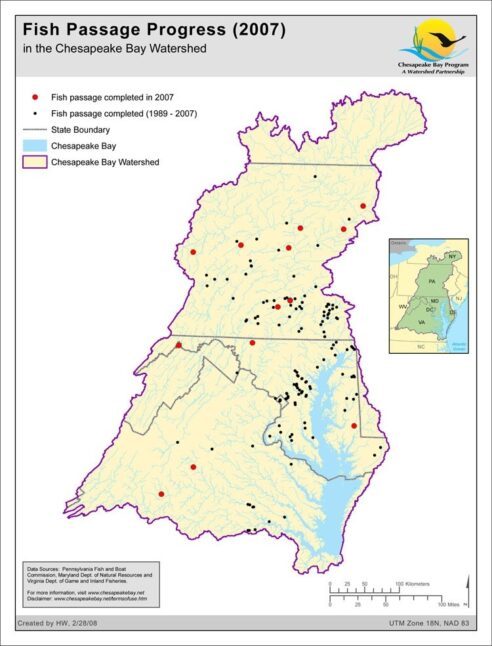Maps
Browse through maps depicting Bay health and restoration, including pollution trends, public access sites and more.
Fish Passage Progress (2013) in the Chesapeake Bay Watershed
Date created: March 27, 2014Fish passage is a key component to the restoration of anadromous fish (shad and river herring) in the Chesapeake Bay watershed. These fish are blocked from much of their historic spawning areas, which included waters over 200 miles from the Bay. Maryland, Virginia, Pennsylvania and the District of Columbia have set goals to provide fish passage to make much of those historic spawning areas once again accessible to migratory fish. Other species that benefit from the unblocking of streams include eels, native species such as brook trout and other resident species.
View mapFish Passage Progress (2012) in the Chesapeake Bay Watershed
Date created: April 2, 2013Fish passage is a key component to the restoration of anadromous fish (shad and river herring) in the Chesapeake Bay watershed. These fish are blocked from much of their historic spawning areas, which included waters over 200 miles from the Bay. Maryland, Virginia, Pennsylvania and the District of Columbia have set goals to provide fish passage to make much of those historic spawning areas once again accessible to migratory fish. Other species that benefit from the unblocking of streams include eels, native species such as brook trout and other resident species.
View mapFish Passage Progress (2011) in the Chesapeake Bay Watershed
Date created: March 27, 2012Fish passage is a key component to the restoration of anadromous fish (shad and river herring) in the Chesapeake Bay watershed. These fish are blocked from much of their historic spawning areas, which included waters over 200 miles from the Bay. Maryland, Virginia, Pennsylvania and the District of Columbia have set goals to provide fish passage to make much of those historic spawning areas once again accessible to migratory fish. Other species that benefit from the unblocking of streams include eels, native species such as brook trout and other resident species.
View mapFish Passage Progress (2010) in the Chesapeake Bay Watershed
Date created: April 4, 2011Fish passage is a key component to the restoration of anadromous fish (shad and river herring) in the Chesapeake Bay watershed. These fish are blocked from much of their historic spawning areas, which included waters over 200 miles from the Bay. Maryland, Virginia, Pennsylvania and the District of Columbia have set goals to provide fish passage to make much of those historic spawning areas once again accessible to migratory fish. Other species that benefit from the unblocking of streams include eels, native species such as brook trout and other resident species.
View mapFish Passage Progress (2009) in the Chesapeake Bay Watershed
Date created: February 12, 2010Fish passage is a key component to the restoration of anadromous fish (shad and river herring) in the Chesapeake Bay watershed. These fish are blocked from much of their historic spawning areas, which included waters over 200 miles from the Bay. Maryland, Virginia, Pennsylvania and the District of Columbia have set goals to provide fish passage to make much of those historic spawning areas once again accessible to migratory fish. Other species that benefit from the unblocking of streams include eels, native species such as brook trout and other resident species.
View mapFish Passage Progress (2008) in the Chesapeake Bay Watershed
Date created: March 18, 2009Fish passage is a key component to the restoration of anadromous fish (shad and river herring) in the Chesapeake Bay watershed. These fish are blocked from much of their historic spawning areas, which included waters over 200 miles from the Bay. Maryland, Virginia, Pennsylvania and the District of Columbia have set goals to provide fish passage to make much of those historic spawning areas once again accessible to migratory fish. Other species that benefit from the unblocking of streams include eels, native species such as brook trout and other resident species.
View mapFish Passage Progress (2007) in the Chesapeake Bay Watershed
Date created: February 28, 2008Fish passage is a key component to the restoration of anadromous fish (shad and river herring) in the Chesapeake Bay watershed. These fish are blocked from much of their historic spawning areas, which included waters over 200 miles from the Bay. Maryland, Virginia, Pennsylvania and the District of Columbia have set goals to provide fish passage to make much of those historic spawning areas once again accessible to migratory fish. Other species that benefit from the unblocking of streams include eels, native species such as brook trout and other resident species.
View map
